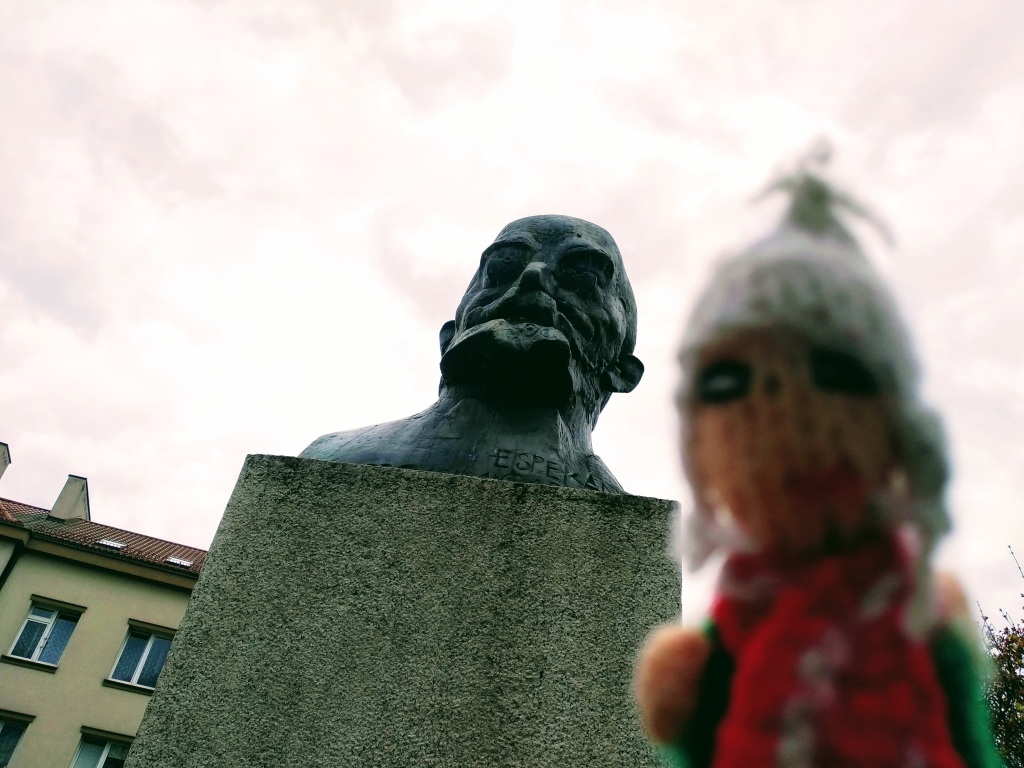Two months, day forty-seven: Białystok
Finfine mi vizitas la muzeon de La Hof.

Unhindered by work in the afternoon I decided I'd set off and do some exploring.
There was some difficulty getting up in the morning but eventually I made it to the kettle and then after some coffee managed to gird my loins sufficiently that by lunchtime I had settled myself in my now-favourite café on the not-square for more coffee. From there I had something of an Esperanto-y day, as I checked out the two Zamenhof statues, pottered by the site of his birthplace, and then headed off to the Centrum Zamenhofa to have a nose around the best Hof Museum I've seen so far this trip.
Although he spent most of his life in Warsaw, Białystok is proud of Ludwik Lejzer Zamenhof, an ophthalmologist who was born on December 15th 1859 in a small wooden house on Zielona Street where his family lived on the ground floor. Then part of the Russian Empire, Belostok was a multi-ethnic city where as a young child walking to school every day, Zamenhof would witness people kept apart from each other by the use of their own mother tongues. He himself was something of a polyglot, speaking Russian and Yiddish as mother tongues, and having learned German and French from his father, a language teacher.
Additionally, he spoke the other languages of Białystok such as Polish (forbidden in public) and Belarusian and also studied Italian and Lithuanian.

As a child this linguistic segregration troubled him and aged ten he wrote a play, Tower of Babel, or the Białystok Tragedy in Five Acts; he believed that the main cause of misunderstandings and disputes between people is the language barrier. One common language was supposed to be the solution to this and at secondary school in Warsaw, he set about creating a universal language. Once he'd studied English - along the way picking up some knowledge of Latin, Greek, and Hebrew - he decided simplification of the language was required if people were to learn it and in 1879 at age 19, his universal language project was finished.
It would take another nine years - during which he studied medicine in Moscow and later Warsaw, started work as an ophthalmologist, and continued work on the project - before he would publish his guide to the language, International language: Introduction and complete textbook, which would later become known as Esperanto by those who spoke it.
Duolingo teaches it, which is how I ended up sleeping on a camp-bed in the office of Białystok's Esperanto club (which may now contain a few extra pairs of googly eyes).

The house has long since gone, but the street where it stood is now named in his honour and the building that now stands in the place of the Zamenhof home has a mural which makes up some of the street art that covers many walls in Białystok. The cultural centre which bears his name has a small museum on the ground floor with a multimedia presentation of Białystok in Zamenhof's times, and a(n inaccessible) bookshop on the first floor.
During my wanderings I was happy to find another bear, Ursido, in the afternoon (right next to the Zamenhof mural, in fact) which means I now have two of the eight.
In the evening I ended up being talked into giving a presentation to the club about my trip, which essentially consisted of an hour-long slideshow of a finger puppet against differing blurry backgrounds. I couldn't really tell if they were impressed or not, but by the time I came back from my short lesson mid-way, more than half had gone. So perhaps not.
My lunchtime falafel in a box came from KebabHub which, when I had it, was just what I needed.
Later in the evening I slipped to the bar for a quiet half which remained a quiet half (or perhaps two) because a woman sidled up to me to tell me about her dead cat, at least four times. Of minor concern was her reiteration that she'd had to put it down, rather than have it put down, which I decided to attribute to linguistic difficulties rather than explore further.
She'd apparently not had a drink in at least six months and had chosen the occasion of her cat's passing as an opportunity to experiment with spirits. My suggestion that her cat would've eaten her by now had the roles been reversed and that she should just get another cat seemed not to comfort her particularly and after a while she had to leave because, for some unfathomable reason, talking to me about her dead cat made her cry.
Zamenhof was right.